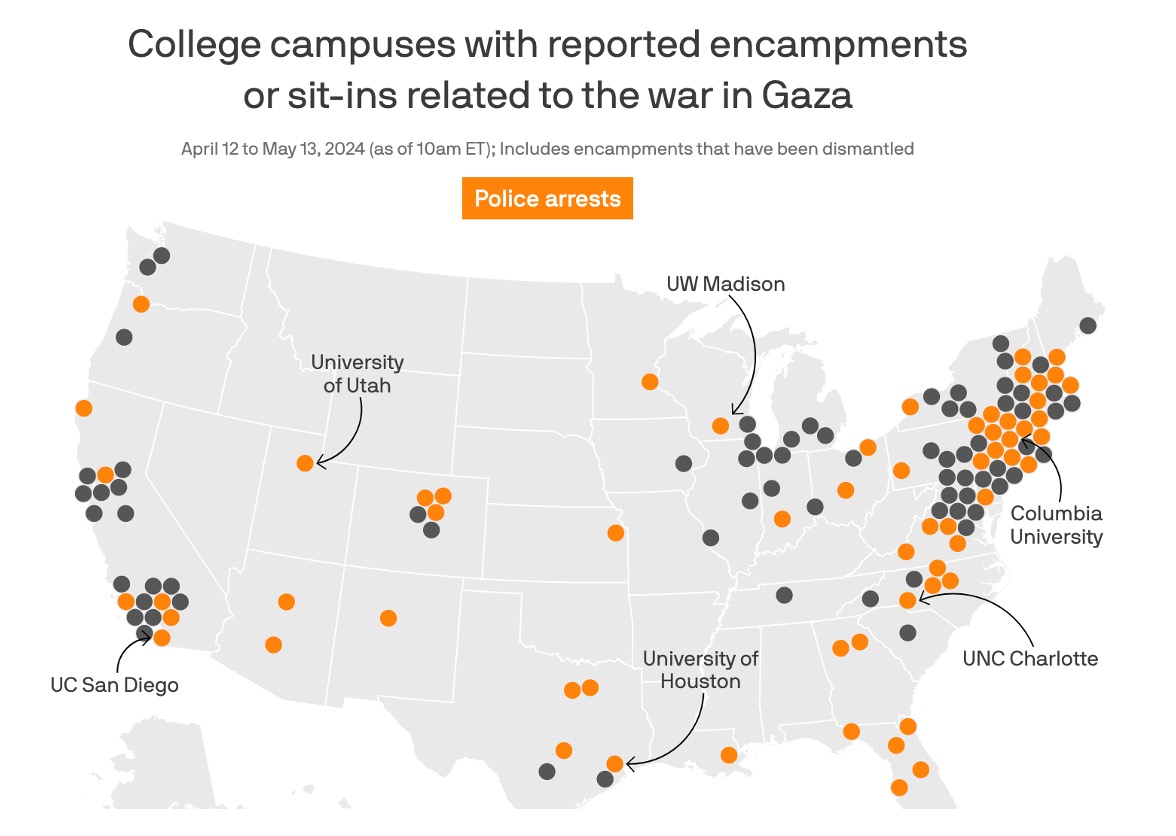Comments
UCLA DEMONSTRATIONS - Two groups of off-campus “outside agitators” attacked the student encampment at UCLA between April 30 and May 2, 2024.
On April 30 and May 1 the campus police and UCLA’s rent-a-cops stood by for four hours, while vigilantes pummeled the students, sending 25 of them to the hospital. After urgent phone calls, the LAPD eventually showed up and stopped the mayhem. Using their computer skills, the students soon identified some of the vigilantes, and the Grayzone and CNN published their names. Despite this evidence, the police have not arrested any attackers.
In the early morning of May 2, a second group of outside agitators were entered the UCLA campus to forcefully dismantle the encampment. They also arrested 210 students and faculty. These outsiders were from the LAPD, California Highway Patrol, and Santa Monica and Beverly Hills police departments.
These back-to-back efforts to squash UCLA’s student encampment offer four lessons about the limits of free speech in the United States.
Lesson #1. The same pattern appeared across the entire United States over the past month. According to the news site Axios, between April 12 to May 13 police raided 55 college campus encampments and made over 2000 arrests. Like similar assaults on the Occupy Movement a decade ago, these raids came late at night, were often violent, and relied on flimsy legal charges. In the case of UCLA, the students were guilty of “suspicion of failing to disperse.” The LA Times reported the police wore body armor, helmets, face shields, and fired many flash-bang grenades.

Lesson #2. Many analysts have compared these quickly expanding campus encampments in the United States, Canada, Europe, Japan, and Australia to the anti-Vietnam war movement. While there are similarities, since both movements opposed US-supported foreign wars, there are several important differences.
First, the Vietnam anti-war movement (1964-1972) also opposed the military draft and successfully organized within the US military. Second, the US lost the Vietnam war, and the US government ended military conscription and withdrew its remaining troops from Vietnam in 1972.
This is why a better comparison is the Occupy Wall Street movement of 2011 and early 2012, when there were encampments or protests in all 50 states, plus Canada, Europe, South America, Africa, and Asia.
Lesson #3: Some Occupy Wall Street encampments shut down on their own, but many were assaulted by the police. These synchronized police attacks have been well documented via redacted documents obtained through Freedom of Information requests. In 2011 the police assaults against the Occupy encampments also took place late-at-night, involved multiple police agencies, and relied on flimsy legal charges. The Obama White House directed these raids through the Department of Homeland Security, FBI, Fusion Centers, and local police agencies. The public won’t know the potential role of the Biden White House until independent investigators receive answers to their Freedom of Information requests.
Lesson #4: Although the two attacks on the UCLA encampment appeared much different, they had several things in common. First, they had the same objective, to shut the student encampment down. Second, without the police standing down for four hours, the vigilantes could not have violently attacked the encampment and sent 25 students to the hospital.
This is what we know about these vigilantes so far. According to Ian Masters’ Background Briefing podcast, “Neo-Nazis, Christian Nationalists, and Proud Boys were in the pro-Israel mob at UCLA claiming to fight anti-Semitism." CNN also did extensive research on the counter-protesters and identified them as extremely violent, non-student, off-campus, pro-Israel provocateurs.
These lessons reveal that the organized assaults on protest movements are two sides of the same coin. The “liberal” side is structured through the Department of Homeland Security, Fusion Centers, and local police, with White House guidance. The “conservative” side of the coin relies on thugs discreetly assisted by local police and college administrators.
Many commentators note that the donor class forced college presidents to request local police departments to raid the Gaza encampments. These donors are extremely rich people who realize that constitutionally protected speech does not apply to their private sector companies. They are quick to extend this precedent to the universities they donate to. This does not, however, contradict the role of the Federal Department of Homeland Security since, according to the Guardian in 2012, “ . . .documents (obtained through Freedom of Information requests) show these federal agencies functioning as a de facto intelligence arm of Wall Street and corporate America" to assault Occupy encampments.
(Victor Rothman is a California-based policy analyst.)






